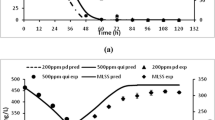Abstract
A series of pure bacterial strains belonging mainly to theRhodococcus andPseudomonas genera were grown on one of the following polycyclic aromatic hydrocarbons (PAH) supplied as sole carbon and energy source: naphthalene, fluorene, phenanthrene, anthracene, fluoranthene and pyrene. In each case, a quantitative evaluation of the carbon repartition of the PAH degraded into CO2, biomass and water-soluble metabolites was carried out. In addition, the kinetics of oxygen consumption and of water-soluble metabolite accumulation during PAH biodegradation was followed with respirometric equipment. Satisfactory carbon balances were obtained and the data correlated well with oxygen consumption values. The results show that growth on PAH presents high mineralization yields (from 56% to 77% of carbon) and sizeable production of biomass (from 16% to 35% of carbon) and limited but significant accumulation of metabolites (from 5% to 23% of carbon). The mineralization yields were higher and biomass yields lower in the case of higher PAH. Some differences between strains were also observed.
Similar content being viewed by others
References
Abbott BJ (1973) The prediction of substrate yield coefficients. Process Biochem 4:13–15
Bouchez M, Blanchet D, Vandecasteele JP (1995a) Degradation of polycyclic aromatic hydrocarbons by pure strains and by defined strain associations: inhibition phenomena and cometabolism. Appl Microbiol Biotechnol 43:156–164
Bouchez M, Blanchet D, Vandecasteele JP (1995b) Substrate availability in phenanthrene biodegradation: transfer mechanism and influence on metabolism. Appl Microbiol Biotechnol 43:952–960
Breure AM, Volkering F, Andel JG van (1991) Microbial conversion of naphthalene, phenanthrene and anthracene. In: Verachtert H, Verstraete W (eds) International symposium. Environmental biotechnology. Part II. Royal Flemish Society of Engineers, Antwerpen, pp 425–428
Cerniglia CE (1992) Biodegradation of polyclic aromatic hydrocarbons. Biodegradation 3:351–368
Grifoll M, Casellas M, Bayona JM, Solanas AM (1992) Isolation and characterization of a fluorene-degrading bacterium: identification of ring oxidation and ring fission products. Appl Environ Microbiol 58:2910–2917
Guerin WF, Jones GA (1988) Mineralization of phenanthrene by aMycobacterium sp. Appl Environ Microbiol 54:937–944
Heitkamp MA, Cerniglia CE (1988) Mineralization of polycyclic aromatic hydrocarbons by a bacterium isolated from sediment below an oil field. Appl Environ Microbiol 54:1612–1614
Herbert D, Phipps PJ, Strange RE (1971) Chemical analysis of microbial cells. In: Norris JR, Ribbons DW (eds) Methods in microbiology, vol 5B. Academic Press, London New York, pp 209–344
Kelley I, Cerniglia CE (1991) The metabolism of fluoranthene by a species ofMycobacterium. J Ind Microbiol 7:19–26
Keuth S, Rehm HJ (1991) Bioderadation of phenanthrene byArthrobacter polychromogenes isolated from a contaminated soil. Appl Microbiol Biotechnol 34:804–808
Kiyohara H, Nagao K (1978) The catabolism of phenanthrene and naphthalene by bacteria. J Gen Microbiol 105:69–75
Roels JA (1980) Application of microscopic principles to microbial metabolism. Biotechnol Bioeng 22:2457–2514
Stouthamer AH, Verseveld HW van (1985) Stoichiometry of microbial growth. In: Moo-Young M (ed) Comprehensive biotechnology, vol 1. Pergamon, Oxford New York Toronto, pp 215–238
Stucki G, Alexander M (1987) Role of dissolution rate and solubility in biodegradation of aromatic compounds. Appl Environ Microbiol 53:292–297
Walter U, Beyer M, Klein J, Rehm HJ (1991) Degradation of pyrene byRhodococcus sp. UW1. Appl Microbiol Biotechnol 34: 671–676
Weissenfels WD, Beyer M, Klein J (1990) Degradation of phenanthrene, fluorene and fluoranthene by pure bacterial cultures. Appl Microbiol Biotechnol 32:479–484
Wodzinski RS, Coyle JE (1974) Physical state of phenanthrene for utilization by bacteria. Appl Microbiol 27:1081–1084
Wodzinski RS, Johnson MJ (1968) Yields of bacterial cells from hydrocarbons. Appl Microbiol 16:1886–1891
Author information
Authors and Affiliations
Rights and permissions
About this article
Cite this article
Bouchez, M., Blanchet, D. & Vandecasteele, J.P. The microbiological fate of polycyclic aromatic hydrocarbons: carbon and oxygen balances for bacterial degradation of model compounds. Appl Microbiol Biotechnol 45, 556–561 (1996). https://doi.org/10.1007/BF00578471
Received:
Revised:
Accepted:
Issue Date:
DOI: https://doi.org/10.1007/BF00578471




